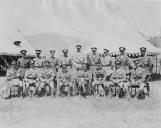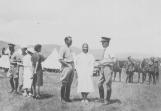16
Shortage of money also affected the training of officers and non-commissioned officers (NCOs). In order to qualify for promotion officers and NCOs were required to travel to regular force training facilities outside of the Okanagan Valley, often for periods of weeks, for courses and examinations in modern tactics and techniques. Many of the men could not afford to be away from their jobs for that length of time. To alleviate that problem regular force instructors were sometimes dispatched to local communities to teach courses at night. After the onset of the Depression, the numbers of officers permitted to attend courses and the number of instructors sent, was not sufficient to satisfy the need.In 1929, the regiment became the BC Dragoons as it was thought that it would help avoid any future deployment as Infantry. In 1935, the Department of Defence paid $1,000.00 to obtain the old school on Richter St. in Kelowna, for 'B' squadron, as a temporary armoury. With reasonable accomodations in Kelowna, RHQ was moved there in 1936. This became one of many moves back and forth between Vernon and Kelowna.
18
Cavalry training was exciting. Mounted drill with sword or lance remained the staple of training throughout those years. Exercises included bare-back wrestling in which mounted troopers without saddles, would wrestle opponents off their mounts without losing their own. Another favorite was tent pegging in which a galloping trooper would attempt to uproot a tent peg with his lance. Miscalculations could render the man unhorsed in very short order. Finally, there was the 'Balaclava Melee' in which mounted teams of four heavily padded troopers charged each other, swinging wooden swords with the winners being those who succeessfully knocked paper ribbons from the tops of their opponent's helmets without losing their own.Of course, many recruits didn't know how to ride. Older veterans recall a full-sized wooden replica horse inside the Kelowna Armoury for training newcomers how to saddle, bridle, and sit when it came to the real thing. Outside, a typical drill involved tying the halter of a horse to the tail of the one in front with approximately twenty mounts secured this way in a circle. The recruits would ride bare-back at the trot, and the gallop, round and round, falling off and getting back on, until they could be assured of staying on.



